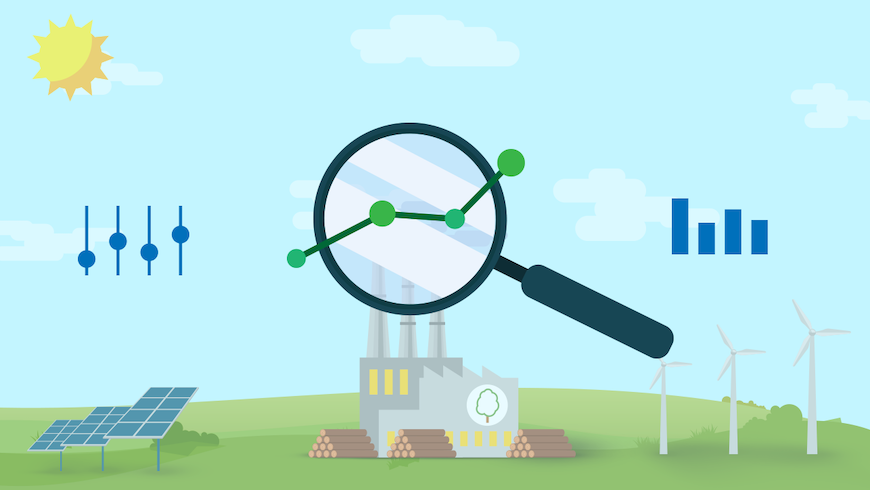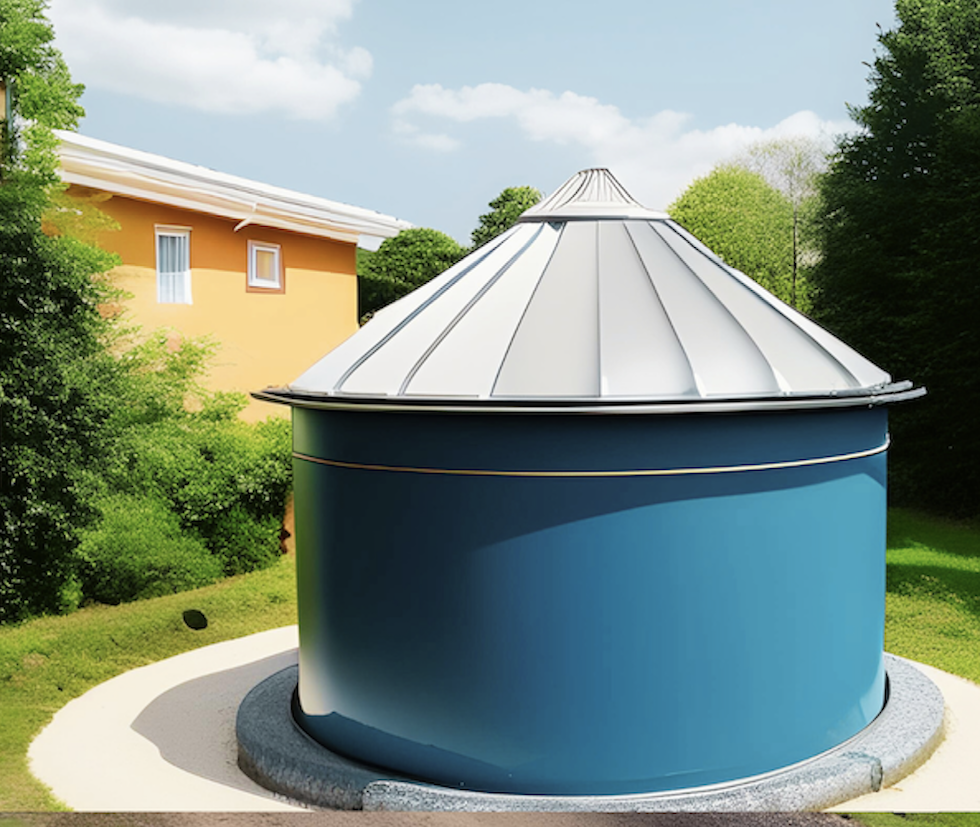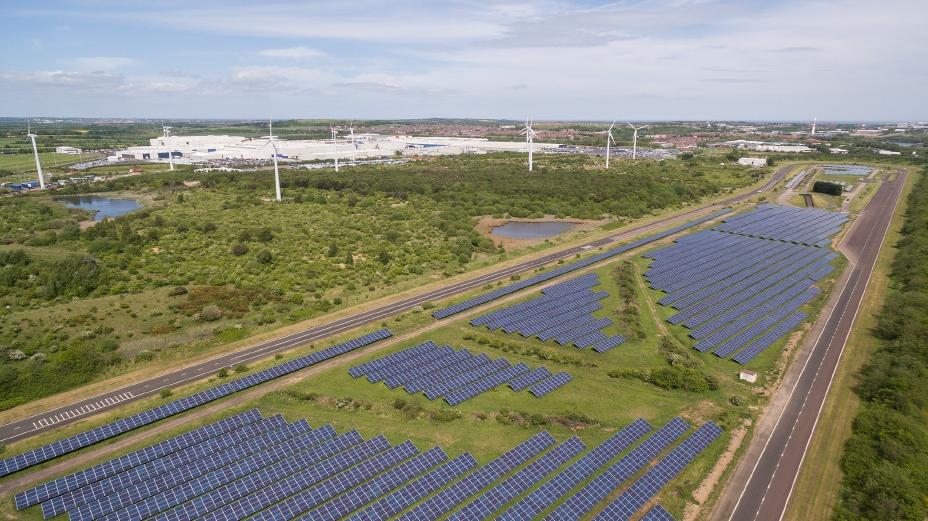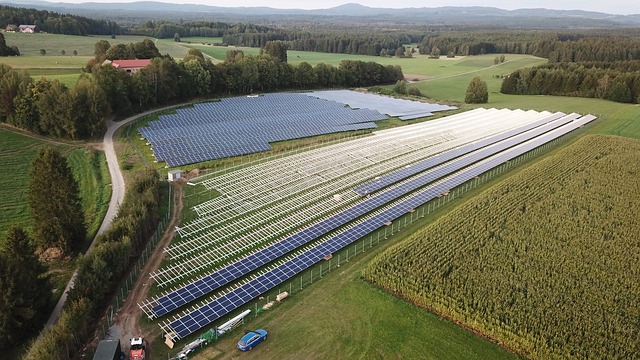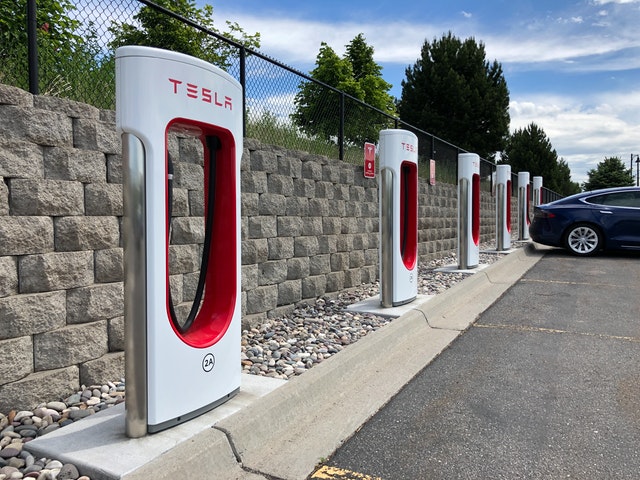Energy has been the prime driver of global economic development, industrialization and modernization ever since the dawn of civilization. With such rapid growth in industrial activities and the escalating human population in the 18th, 19th, and 20th centuries, fossil fuel dependency is prevalent worldwide. Such dominance of the non-renewable energy sources in the world's energy sector has posed a significant threat to the environment. Experts worldwide have forecasted that the non-renewable energy sources will eventually run out soon if the current energy demand trend continues over the coming years. The ever-growing energy demand has thus resulted in the global energy crisis. Moreover, the substantial reliance on fossil fuels has increased the need to shift towards renewable energy sources without further delay.
The use of renewable energy as the primary energy source can cater to the global energy crisis and meet the massive energy demand of the world. On the other hand, it can reduce carbon and other harmful emissions, thereby reducing the burning problems of the greenhouse effect and global warming to a great extent. Moreover, renewable or green energy will play a significant role in decarbonizing our current energy system in the coming years.
In recent years, much progress has been made in cleaner alternate energy sources, and new renewable energy technologies are being developed. But, how much renewable energy is precisely being produced as of now? Will, the energy produced be ample for the generations to come? Find out all about the current status of renewables and clean energy sources and technologies in this article. The present article focuses mainly on the current renewable energy data of the world, including the general statistics of solar energy, wind energy, geothermal energy, hydro energy, biomass energy and tidal energy in the world.
How much of the world's energy is renewable?
In current years, renewable energy has become the fastest-growing global source of energy. Various sources of renewable energy, mainly wind, hydro and solar power, are being harnessed in many parts of the world to produce large-scale energy. The International Renewable Energy Agency (IRENA) has estimated that different types of renewable energy will provide 86% of the global primary energy by 2050 (IRENA, 2019).
In 2019, renewable energy accounted for approximately 11% of the global primary energy, which is expected to increase considerably in the coming years (Ritchie and Roser, 2020). The demand for renewable energy increased by 3% percent in the year 2020. According to the International Energy Agency (IEA), the use of renewable and alternate energy sources for electricity production is expected to grow by 7% in 2021 (IEA, 2020).
The largest renewable energy source in the world is hydropower, as shown in figure 1 below. According to the survey conducted by the US Energy Information Administration (EIA), hydropower solely accounted for 71% of the electricity produced from renewables in 2015 (EIA, 2017). However, among the various types of renewable energies, wind energy and solar energy technologies have grown at the fastest rate in the past two decades. Reports suggest that the growth rate is so high that the world's renewable energy capacity increased by as high as 45% in 2020 alone, the highest year addition rate since 1999 (IEA, 2020). Further, it has been estimated that if the current trend continues, 270 gigawatts (GW) of renewable energy capacity can be added in 2021. In 2020, the global wind energy capacity of the world almost double to 114GW. Experts have even forecasted that the wind energy capacity will continue to break its record, and the total may increase to over 160 GW by 2022 (IEA, 2021a).
The global energy demand is expected to increase by 4.6% in 2021. Despite the outbreak of the COVID-19 pandemic and its subsequent impact on the worldwide energy market and economy, the renewable energy demand has grown by over 8% in 2021, and the expansion of renewable energy technologies is set to reach new levels in the years to come (IEA, 2021b). Solar panel and wind energy technologies are expected to contribute to around two-thirds of the total growth in the renewable energy sector. Moreover, renewable energy is projected to account for 30% of the electricity generation around the globe by the end of 2021. Overall, EIA has forecasted that renewable energy sources will account for over 31% of the total electricity produced in the world (EIA, 2017). The new heights of exceptional growth in renewable energy technology have thus marked the Renewable energy sector as the only success story of the prevailing era of the COVID-19 pandemic.

Figure 1 shows worldwide renewable energy generation (Ritchie and Roser, 2020)
Also Read: Renewable Energy: Sources and Types
Which Country is leading in Renewable Energy?
In many parts of the world, the innovation and development of advanced renewable energy technologies are increasing rapidly. Different countries have set energy goals and policies to make a shift towards renewable energy sources.
According to IRENA (2021), Asia added 64% of the new renewable energy capacity (261GW) in 2020. Figure 2 below shows that China was leading in installed renewable energy capacity with around 643GW, followed by the US approximately 193GW in 2020. China is adding about 82 GW, followed by the EU around 32GW, and the US around 29GW in 2021 (IEA, 2020).
China is one of the leading investing countries in renewable energy, mainly solar and wind energy, and has successfully installed some of the world’s largest solar and wind farms. Five of the world’s largest solar manufacturing plants and most significant wind turbine manufacturing plants have been built in China. For many years, the country has been contributing to around 40% of global renewable capacity growth. Furthermore, China has set the goal to produce over 35% of the electricity solely from renewable resources by 2030.
The United States of America is one of the countries with enormous energy consumption in the world. The nation has the second-highest installed wind energy capacity after China and the fifth-highest solar panel capacity globally.
Germany is the leading country in the solar energy sector. Moreover, Germany has pledged to generate over 65% of the electricity from different renewable energy sources by the end of 2030.
Iceland and Norway are the two exemplary countries in renewable energy usage as both the countries produce all of their electricity harnessing the various renewable sources. Almost 100% of the energy produced in Iceland is from renewable power: hydropower (72%) and geothermal energy (28%).
Sweden has set an excellent target of eliminating fossil fuels for large-scale electricity production by increasing alternate energy sources such as solar energy and wind energy. Similarly, Denmark is one of the leading countries in the world on wind energy. Also, Denmark is integrating various renewable energy sources.
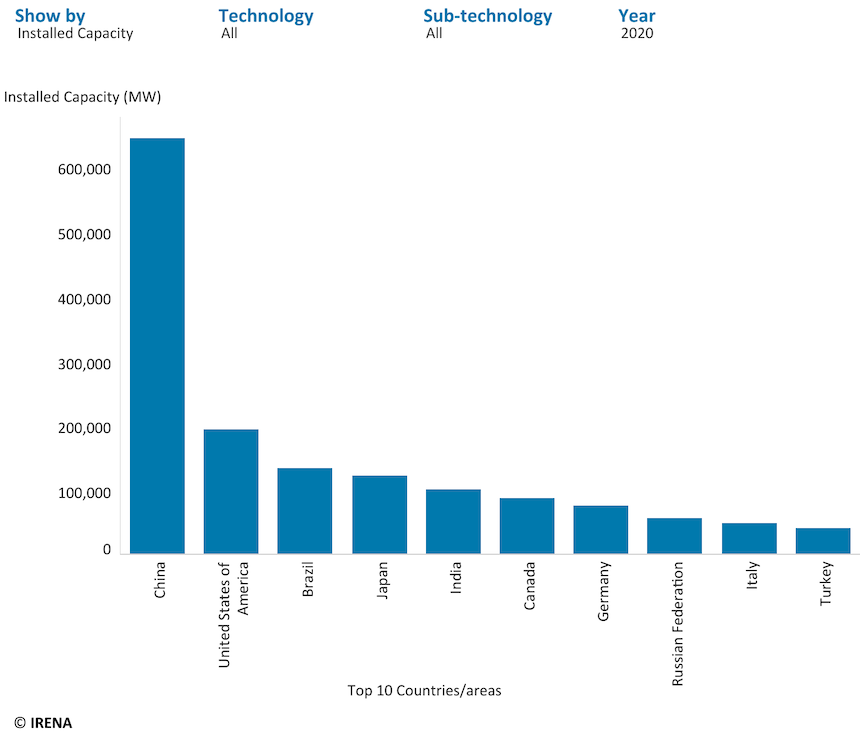
Figure 2: Top 10 countries with renewable energy installed capacity in 2020 (IRENA, 2020)
Major Sources of Renewable Energy
In a simple sense, renewable energy is primarily obtained from natural sources that replenish continuously. Renewable energy is also called alternate clean energy and green energy because renewable energy is carbon neutral with zero emissions and non-polluting in nature. The primary sources of renewable energy include solar energy, wind energy, hydro energy, tidal energy, geothermal energy, and biomass energy.
The primary sources of renewable energy have been further described in brief as follows:
1. Solar Energy
Introduction
Solar energy is the type of renewable energy obtained by harnessing the energy present in the sunlight. Sunlight is one of the cleanest, most abundant, cost-effective and readily available natural resources. Mainly in everyday practice, photovoltaic solar panels capture the energy from the sunlight and convert it into usable clean energy. Solar panels can be deployed both for residential and commercial use. Solar energy can also be used for various thermal applications such as powering heating systems in houses and industries.
Nowadays, large scale photovoltaic solar panels with the capacity of generating high Mega Watts of power for distributing solar energy to a large group of utility users or customers are being installed in many parts of the world.
Solar Energy as Renewable energy Source
Solar energy is one of the prominent sources of renewable energy as each location where the sunlight falls can be a potential source for solar power generation. The energy produced by harnessing sunlight is profoundly clean, renewable and economical. Sunlight is the most readily available and abundant resource and can be utilized to generate limitless power. The Earth receives an unlimited amount of sunlight every day that can be converted into electricity even for generations in the future. Thus, solar power is one of the most dependable renewable sources of energy.
How does Solar Energy Work?
As enunciated earlier, the most common technology used for solar power production is the installation of solar panels. These solar panels are also called solar modules and are essentially made up of layers of silicon cells enclosed in a metal frame and a casing unit of glass. Appropriate wiring units are used to transfer the electric current from the silicon cells. It is common to use silicon cells in solar panels as silicon has high conductive properties and thus efficiently capture and convert solar energy into electricity. Upon exposure, the sunlight sets the electrons present in the silicon cells to move, which initiates the flow of electric current. The mechanism which transforms UV light into the electric current is known as Photovoltaic Effect. The process of generating usable electricity by applying the photovoltaic effect was discovered by Edmond Becquerel in 1839.
The process of conversion of solar energy to electricity consists of the following steps:
a. The solar radiation present in the sunlight is absorbed by the photovoltaic solar cell.
b. The solar radiation further interacts with the silicon cell causing the electrons to move. As a result, an electric current or direct current (DC) is produced.
c. The direct current produced is then transferred to a solar inverted through the wires and are thus converted to alternating current (AC), i.e. electricity.
Also Read: What is Solar Energy? Pros and Cons. Why should you Go Solar?
Major Uses of Solar Energy
The use of solar energy varies from small-scale residential use to powering large scale industrial plants and utilities. The primary application areas of solar energy can be listed as follows:
a. Solar Electricity
b. Solar Water Heating
c. Solar Heating Systems
d. Solar Ventilation
e. Solar Lighting
f. Solar Distillation
g. Solar Drying (Agricultural and Animal Products)
h. Solar Furnaces
i. Solar Cooking
j. Solar Thermal Power
k. Solar Green Houses
l. Solar Battery Powered Vehicles
2. Wind Energy
Introduction
Wind energy is the type of renewable energy that is produced from the wind. The wind is one of the most abundant clean and renewable energy sources in the world. The generation of immense scale power by harnessing energy from blowing wind is one of the fastest-growing renewable energy technologies globally. Reports of the past two decades suggest that the global installed wind generation capacity has increased by a factor of seventy-five (IRENA, 2020).
The energy of the wind is captured and converted to usable electricity using a device known as the turbine. Wind turbines produce electricity by utilizing the kinetic energy possessed by the wind in motion. Large scale wind farms with high electricity generation potential for a large group of utility customers have been installed in many parts of the world. Wind energy is an inexhaustible and clean source of energy with zero emissions. Wind power can be harnessed from offshore and onshore wind farms.
Moreover, wind energy technology is becoming cost-effective. The use of wind energy for powering domestic and large-scale application areas can thus lead the energy sector towards a sustainable future.
Wind Power as Renewable energy source
The wind is plentiful and inexhaustible. The wind is a clean or green source of renewable energy as it does not emit any harmful substances, pollutants or particulates into the air. The technology for wind power production is also considered environmentally friendly and does not result in carbon dioxide, greenhouse gases, and other air pollutants. The use of wind turbines for electricity production does not emit harmful gases and toxic substances that can harm the environment and the ecosystem. Thus, wind energy technology is one of the leading renewable energy technologies for producing green energy in a highly sustainable manner.
How Does Wind Energy Work?
The kinetic energy present in the blowing wind is utilized to generate electricity employing wind energy conversion systems or wind turbines. The sun initiates the working of wind energy. When sunlight falls on the lands of Earth, the air or wind just above the lands get heated up. The heated wind slowly rises as the volume of the hot air is much lighter than cold air of the same volume. The cooler wind then blows to fill up the voids or spaces occupied by the hot air initially. The gust of wind thus formed in turn run or spin the blades of the turbine. The blade's spinning applies pressure on the rotor and the internal shaft of the turbine to spin at about 30 to 60 revolutions per minute. This process converts kinetic energy into rotational energy. The generator attached to the shaft then converts the rotational energy into electric energy by electromagnetism. The generator houses an assembly of magnets and wiring systems that generate the required voltage by electromagnetic induction. The generator connected to a gearbox increases the spin rate from 1000 to 1800 revolutions per minute as the generator requires a high spin rate.
Mostly, the total amount of power output obtained from wind depends upon the size of the turbine and the length of the blades mounted on it. In general, the energy production capacity of a wind turbine is directly proportional to the rotor blade's dimensions and the cube of the wind’s speed. Generally, the energy from wind increases by almost a factor of eight when the wind speed is doubled (IRENA, 2020). Wind turbine technology for the production of electricity has dramatically advanced over time. Earlier, a typical wind turbine used for commercial projects had about 2MW onshore and 3 to 5MW offshore. Nowadays, large wind farms can generate above 8MW power and have more than 164 meters of rotor blades diameter.
Major Uses of Wind Power
Wind energy is mainly used more for large scale applications rather than for other domestic uses. The primary application areas of wind energy can be listed as follows:
a. Wind Power & Electricity Generation
b. Food Production Systems
c. Water Heating Systems
d. Pumping Systems
e. Wind-Powered Vehicles
f. Wind-Powered Cargo Ships
g. Powering Mills
3. Hydro Energy/ Hydro Power
Introduction
Hydro energy is a type of renewable energy that utilizes the power of flowing water to generate electricity. It is also commonly known as hydroelectricity or hydroelectric power. In simple terms, hydroelectricity or hydropower is the energy essentially derived from a flowing water source.
Hydro energy is one of the oldest forms of energy harnessed by humankind since ancient times. Hydropower was used by the ancient Greeks to power and run the milling wheels for grinding the food grains more than two thousand years ago. Now, hydropower technology is one of the leading and most commonly used alternate technologies for electricity generation worldwide. Norway is an exemplary nation where hydropower accounts for 99% of the total electricity produced. Even in rural areas, small scale hydropower plants are becoming good alternative options for electricity generation.
The countries that top the list in the hydropower sector are China, the United States of America, Brazil, Canada, Russia, and India. The largest hydropower plant globally is the Three Gorges Dam, with 22500 Megawatts of power located in China. The said hydropower plant produces approximately 80 to 100 terawatt-hours of electricity every year, sufficient to power 70 to 80 million households.
Hydro Energy as Renewable Energy Source
Hydro energy is one of the most abundant renewable power sources on Earth. The energy is derived from the water resources replenished by the Earth's water cycle, including rainfall and runoff. A conventional hydropower plant has 90% efficiency in converting the kinetic energy present in the water to usable electricity. Therefore, a single hydropower plant itself can produce an ample amount of electricity.
Moreover, the entire process of electricity generation from hydro energy does not require burning any fuels. Likewise, hydropower doesn’t release harmful emissions into the atmosphere, therefore, making hydropower one of the clean and cost-effective forms of energy. Due to these reasons, hydropower is the most frequently used renewable source of energy.
Hydropower alone accounted for 71% of the total renewable electricity generated in 2016. In 28 countries of the European Union, hydropower supplies over 14% of the usable electricity and 70% of the hydropower generated are from five significant countries, namely Sweden, France, Italy, Austria and Spain (McEntee, 2018).
How does Hydro Energy Work?
Hydropower generates electricity by utilizing forces of flowing water to drive the turbines. A typical hydropower plant consists of two basic units, namely dams and reservoirs. However, small scale hydropower plants installed for domestic purposes do not comprise dams and reservoirs. Such hydropower plants are designed to function in a river without significantly interrupting the river's flow and are thus more environmentally friendly. Due to this reason, many experts and professionals prefer the installation of several small-scale hydropower plants than a large one.
The hydroelectric plants with high megawatts of electricity generation potential have large reservoirs that can store a considerable amount of water over a long period and are ideal for meeting the peak demand. In such hydropower plants, the units can also be divided into smaller dams for serving different functions such as seasonal storage, night or day use, pumping, irrigating lands and electricity generation.
In most hydropower plants, the reservoir for water storage is connected to a gate or valve. The primary function of the valve is to control the flow of water from the reservoir. The water from the reservoir is allowed to flow to a specific area called an outlet. The water possesses potential energy, which is thus converted to kinetic energy as the water flows over the dam, i.e. while flowing from an area in higher elevation to the one in lower elevation. The kinetic energy of the flowing water rotates the blades of the turbine and generates rotational energy. This energy is further converted to electric current utilizing a generator. The electricity produced is then fed to the grid transmission systems and supplied to many utility consumers.
Types of hydroelectric power plants:
a. Impoundment Facility: The impoundment type of hydropower plant is the most widely used hydropower plant. In this type of facility, the construction of a dam controls the water flow collected and stored in the reservoir. When the water is released and allowed to flow from the dam, the flowing water produces high kinetic energy. The downward flowing water spins the turbine's blades at high speed, allowing the generator to produce adequate electricity.
b. Diversion Facility: This type of hydropower plant is not usual. In this type of facility, several canals constructed can control the water flow in a river. The river's flow is channelized and diverted towards the turbines that power the generators to produce electricity.
c. Pumped Storage Facility: Pumped storage facility is the type of hydropower plant that has been recognized as the world’s most potent renewable or battery technology as it accounts for more than 94% of the installed energy storage capacity. Modern pumped storage hydropower plants can even collect and store the sun's energy, wind and nuclear power for long term future use.
However, this hydropower plant stores energy by pumping water from a reservoir or pool at a lower elevated area to a reservoir located in a higher elevated area. During peak time, the water stored earlier in the higher reservoir is released, and it flows down to the pool at the lower reservoir. The kinetic energy possessed by the flowing water is used to rotate the turbine's blades and is converted to electricity using a generator.
Major Uses of Hydro Energy
Hydropower can be deployed as both domestic as well as a commercial-scale green energy source. The practical uses or application areas of hydropower are but are not limited to the following:
a. Large Scale Electricity Generation
b. Powering Milling Industries
c. Water Supply Systems
d. Flood Control Systems
e. Irrigation and Fishing System
f. Powering Industrial Plants and Pumping Systems
4. Geothermal Energy
Introduction
Geothermal energy is the type of renewable energy that is extracted from the Earth’s subsurface. It is derived from the heat trapped in the rocks and the fluids beneath the Earth’s crust. Geothermal energy can be derived from inside the subsurface of the Earth up to the layer where magma, the hot molten rock, is present.
Based on its nature and properties, geothermal energy can be used for various purposes such as heating and cooling applications, clean electricity generation etc. Several geothermal technologies have been developed over the years. The oldest form of technology is dry steam geothermal technology.
According to the Geothermal Energy Association, more than 80 nations use geothermal energy (Huttrer, 2020). The United States of America is home to some of the largest geothermal plants and is the largest producer of geothermal energy globally. The Geysers located in California is one of the largest geothermal fields spread over 117 square kilometers and contains 22 energy plants with a total capacity of 1.5 gigawatts. Iceland is another country pioneering in the geothermal energy sector since 1907. The country has abundant geothermal energy sources as it is abode 600 hot springs and 200 volcanoes. Iceland produces 25% of the total energy produced in the country each year from its five large geothermal plants (Unwin et al., 2019).
Many other countries such as El Salvador, New Zealand, Kenya and the Philippines also use geothermal energy to produce large-scale electricity. According to the data collected by IRENA, geothermal energy has increased from 10 gigawatts in 2010 to 13.3 gigawatts worldwide in 2018 (IRENA, 2019). The growing popularity of geothermal energy is independent of the weather conditions and other capacity factors, making it desirable to produce baseload electricity and other utilities and services.
Geothermal Energy as Renewable Energy Source
Geothermal energy is one of the inexhaustible renewable sources of energy present in the core of the Earth. This energy can be readily derived from the Earth’s crust as an unlimited amount of heat is continuously formed inside the Earth. Geothermal energy extraction does not require burning fossil fuels, making it a clean and sustainable energy source. Geothermal energy is readily available anytime, and abundant power can be generated. On average, geothermal power plants have 90% higher availabilities in comparison to conventional coal plants. Using geothermal energy as the prime energy source can significantly reduce the dependence on carbon-emitting fossil fuels. Moreover, the binary geothermal plants do not emit any harmful gases or liquids and pollute the environment.
How does Geothermal Energy Work?
The basic principle behind harnessing geothermal energy is trapping the energy from the underground hot water reservoirs and driving the turbines and generators to produce electricity. In general, a geothermal power plant or a geothermal heat pump generates geothermal energy, which is further described in brief below:
a. Geothermal Power Plants: Geothermal power plants work by utilizing the heat present within the subsurface of the Earth to generate steam and converting to electricity. A typical geothermal power plant consists of wells drilled up to one to two miles from the Earth’s surface. Steam is then pumped out from the hot springs and pools of underground water using the dug well, converted to usable electricity. The basic steps involved in the production of electricity from a geothermal power plant can be listed as follows:
i. The hot water present on the subsurface is pumped out at high pressure by using the wells.
ii. As the water reaches the surface, the pressure drops, which converts the pumped water to steam.
iii. The steam then drives the turbine connected to a generator which further converts the energy to electricity.
iv. The steam is allowed to cool in cooling water, and the cooled water is then pumped back to the subsurface.
b. Geothermal Heat Pumps: Geothermal heat pumps work by deriving the heat present near the surface of the Earth, mainly for domestic purposes such as heating buildings, heating water etc. In this type of system, pipes are fitted underground, and heat is extracted by pumping water or a particular kind of fluid known as a refrigerant at a constant temperature from 50 to 60-degree Fahrenheit. During the colder season, the water or the liquid absorbs the heat from the subsurface and transfers it to the building, keeping the building warm. While in summer, the heat pumps are operated in a reverse way and help cool the buildings.
Major Uses of Geothermal Energy
The primary application areas of geothermal energy can be listed as below:
a. Electric Power Generation
b. Insulation Systems
c. Water Heating Systems
d. Food Dehydration and Drying Systems
e. Gold Mining Industry
f. Milk Pasteurization Systems
g. Heat Generation in Greenhouses
h. Large Scale Snow Melting
Also Read: What Is Geothermal Energy? Types and Advantages. Why should we care about Geothermal Power Plant?
5. Biomass Energy
Introduction
Biomass energy refers to the energy type obtained from plant materials and other biodegradable organic products. Biomass refers to organic matters such as animal wastes, agricultural residue, forest residue and another biowaste. Biomass essentially consists of the chemical energy stored naturally from the sun. Biomass energy can thus be efficiently used to produce electricity, thermal power and transportation fuels known as biofuels. The conversion of biomass energy to electricity and biofuels is highly energy-efficient and clean as the biomass used as the chief raw material is environmentally compatible. Moreover, using locally available organic matters such as animal dung, crop and agricultural residue for generating power is cheaper.
One of the added advantages of biomass is that it is readily available and can be used in powerhouses and use as an alternative energy source in rural areas. Furthermore, the technology is relatively simple as the biomass feedstock can be directly burnt to generate heat, electricity, and liquid biofuels. Biofuels in the transportation sector can reduce the dependency on conventional gasoline, thereby reducing carbon emissions.
Bioenergy accounts for three-quarters of the world’s renewable energy. Out of which, more than half is produced by utilizing biomass as the primary raw material. The United States of America accounts for more than 20% of the global biomass energy. Large biomass plants with high power generation capacity have been installed in the United Kingdom. The world leader in the production of liquid biofuels from biomass energy is Brazil, where the majority of the vehicles are powered by bioethanol. According to the World Energy Resources (WER), the energy generation capacity of biomass can reach over 150 exajoules by 2035 (WER, 2018).
Biomass Energy as Renewable Energy Source
Biomass is one of the most reliable sources of renewable energy present everywhere as biomass stores energy directly from the sunlight. Biomass feedstock is any organic matter that does not have any adverse impact on the surrounding. A few examples of biomass feedstocks are agricultural residue, animal dung, sawdust, municipal solid waste and other organic waste from plants and animals. Such biomasses are replenishing in nature.
According to the U. S. Energy Information Administration (EIA), biomass provided nearly five quadrillion British thermal units of energy in 2020, which in total accounted for 5% of the primary energy in the United States (EIA, 2020).
Moreover, biomass energy is a carbon neutral and clean source of energy. The use of solid organic wastes products as feedstock for power generation can also contribute to organic waste management. Thus, using biomass energy as a substitute for fossil fuels can significantly reduce the carbon and other greenhouse emissions in the atmosphere. With abundant organic matter on Earth, biomass can be the sustainable primary energy source in developed and developing nations.
Biomass energy is present in the solid, liquid and gaseous forms. Generally, Solid biofuel is the primarily available and convenient form. Firewood and charcoal are examples of solid biofuel. Similarly, liquid biofuel is energy-dense which can replace petrol-diesel and gasoline. Examples of liquid biofuel are bioethanol and biodiesel. The conversion process is complicated and is expensive. Moreover, gaseous biofuel the decomposition and gasification of organic waste generates gaseous biofuels. Examples of gaseous biofuel are biogas and syngas.
Also Read: Biorefinery of Agricultural Residues (Corn Stover)
How does Biomass Energy Work?
The biomass feedstock itself possesses sufficient chemical energy from the sun. The direct burning of such feedstock can convert the chemical energy to heat or steam. Heat or steam is a good energy source for domestic, commercial, and industrial purposes. In most rural areas, small biomass plants have been installed to burn the organic waste to produce electricity for powering homes.
The basic steps of conversion of biomass energy to useful energy are as follows:
1. Organic matters capture and store the chemical energy from the sun. These feedstocks are then fed to the conversion plants.
2. The burning of the biomass feedstocks releases energy in the form of a large amount of heat.
3. The heat produced is converted to steam and transferred through pipes to the turbine.
4. The energy of the steam drives the turbines connected to the generator, which thus produces electricity for powering homes and industries.
Mainly, the following types of conversion processes are used for generating useful energy and fuels from biomass feedstocks:
1. Direct combustion
2. Thermochemical conversion
3. Chemical Conversion
4. Biochemical (Biological) conversion
1. Direct Combustion:
It is one of the most effective ways to utilize biomass as an energy source. In this process, biomass is combusted or burned directly to produce heat. Such produced heat can be used as an energy source for domestic, commercial and industrial purposes, such as heating water and buildings. In some cases, high energy heat is used to generate electricity using steam turbines.
2. Thermochemical Conversion: This process produces solid, liquid, and gaseous biofuels.
a. Pyrolysis:
The pyrolysis process involves burning organic matters at a high temperature ranging from 400 to 500 degrees Celsius without oxygen. The pyrolysis of the biomass feedstock produces commercial bio-diesel and bio-oil.
In fast pyrolysis, also known as hydrotreating, the bio-oil produced by pyrolysis is reacted with hydrogen at high temperature and pressure in the presence of a catalyst to produce biodiesel, renewable gasoline, renewable jet fuel etc.
b. Gasification:
In this thermochemical process, organic matter is treated at elevated temperatures ranging from 800 to 900 degrees Celsius in the presence of controlled amounts of oxygen or steam. The final product is syngas. Syngas is rich in carbon monoxide and hydrogen and can be used as biofuels and generate heat and electricity for various industrial processes.
3. Chemical Conversion:
This process, also known as the transesterification process, produces liquid biofuels. In this process, biomass such as animal fats, vegetable oils, Jatropha seeds, and greases can react chemically with alcohols to produce liquid biofuels such as biodiesel. The most commonly used alcohols are methanol and ethanol, as these are cost-effective and readily available. In most cases, the reaction rate is enhanced by using a suitable catalyst.
4. Biochemical Conversion Process:
This process, also known as the biological conversion process, involves the fermentation process, which produces liquid biofuel (bioethanol) and the anaerobic digestion process, which generate gaseous biofuel (biogas/biomethane). The fermentation process occurs in a bioreactor where microorganisms such as yeasts convert carbohydrate-rich biowaste into (bio)ethanol. In the anaerobic digestion process, the decomposition of biowaste or biomass takes place in an anaerobic bioreactor by different microorganisms to produce biogas/biomethane.
Major Uses of Biomass
Biomass energy is a versatile type of renewable energy having a wide variety of domestic and commercial applications. The primary application areas of biomass are but are not limited to the following:
a. Electricity Generation
b. Liquid Biofuels Production
c. Biogas Production
d. Domestic Use (heating and cooking)
e. Bio-based Industries (energy source)
f. Heat Generation in Steam Turbines
g. Dairy and Livestock Operations
h. Industrial Heating Systems
6. Tidal Energy
Introduction
Tidal energy is a type of renewable energy derived from the tidal currents of ocean waters. In other words, tidal energy is the type of hydro energy obtained from the surge of water during the rise and fall of tides in oceans. The energy thus possessed by the water by the tidal currents is then used to drive the turbines and converted to various forms of power, mainly electricity.
One of the advantages of tidal energy over other renewable energy sources is that the entire process of rising and falling of tides and converting energy to valuable energy is predictable. The tidal movements were first assessed in areas with considerable tidal range and used for electricity production by Engineers in the 20th century.
Despite enormous power production capacity, tidal energy technology is still in the developmental phase. Most tidal power plants operate using a dam or a barrage to harness the power between high and low tide. New technologies for harnessing tidal energy such as tidal current, tidal stream and hybrid technologies are also being developed in many parts of the world.
The largest tidal power plant globally is the Sihwa Lake Tidal Power Station, located in South Korea, with 254MW (IHA, 2016).
Tidal Energy as Renewable Energy Source
Tidal energy is regarded as one of the most dependable renewable energy sources because the moon's gravitational force always rules the ocean waves and currents. The moon’s gravitational pull is practicably inexhaustible. The change in the tidal movements is an inevitable process and will continuously occur, and the energy can be captured three hundred and sixty-five days in a year. Moreover, tidal energy is a clean form of energy and does not cause any sort of pollution.
The technology of producing power by utilizing tidal energy also does not require any use of non-renewable resources. Tidal energy does not emit any greenhouse gas and is a green source of renewable energy. More than 80 percent of the tidal energy harnessed can be converted efficiently into electricity at once.
How does Tidal Energy Work?
The gravitational force of the moon and the sun pulls the water in the oceans upwards. On the other hand, the Earth’s gravitational force tends to pull the water downwards. As a result, high and low tides occur in oceans. The water thus possesses kinetic energy by the up and down movement. The kinetic energy is then utilized to produce usable electricity using a tidal turbine or advanced dynamic tidal power (DTP) technology.
Tidal energy can be captured in several ways. In some countries, energy surface devices that directly capture the electricity through the rise and fall of the ocean waves are laid on the ocean's surface.
While in some parts of the world, underwater energy devices that consist of vertical or horizontal turbines are fitted below the surface. In such a system, a tidal barrage or dam is used to divert the ocean water. Such devices generate electricity by allowing the tidal movement to drive the turbine, which converts the kinetic energy to electric current, similar to a wind turbine. The amount of useful energy produced from tidal energy mainly depends on the tidal movements' height, mass, and speed.
Major Uses of Tidal Energy
The significant uses of tidal energy can be listed as follows:
a. Electricity Generation
b. Powering Grain Mills
c. Energy Storage
d. Coastal Protection Measures
Why should we use Renewable Energy?
Renewable energy is a form of clean energy with numerous environmental benefits. The use of renewable energy as the global prime energy can pave the way to a sustainable future. The utilization of renewable energy sources reduces the dependency on non-renewable energy sources and preserves them for future generations to come. Moreover, renewable power is highly reliable and also provides various green benefits. The installation of different power plants based on renewables can ensure a reliable power supply to meet the global energy demand, thereby enhancing energy security.
Green energy technologies reduce the risk of natural disasters such as the spilling of fuels. In general, renewable energy sources do not emit greenhouse gases or pollutants and thus do not pollute the atmosphere. Apart from the environmental benefits, renewable energy offers different economic benefits. Unlike fossil fuels such as coal and oil, renewable energy does not have to be extracted and transported, enabling cost savings. Furthermore, the development of new renewable technologies can increase the job market and help uplift the living standard of people around the world. Moreover, green energy increases the accessibility of energy use in rural areas of the world.
Benefits of Renewable Energy
The significant environmental and economic benefits offered by renewable energy can be listed as follows:
i. Using renewable energy sources to produce clean energy does not result in any greenhouse emissions and reduces air pollution.
ii. Renewable energy sources are highly reliable and resilient.
iii. The establishment of renewable energy as a significant source of global powering systems can diversify the energy supply and preserve exhaustible energy sources.
iv. The use of new renewable technologies can boost global economic development and offer more job opportunities.
v. Renewable energy can help reduce global warming and landfills.
vi. Renewable energy reduces the possibility of airborne diseases, thereby improving public health.
Renewable Energy Data
The world witnessed remarkable growth in the renewable energy sector in 2020 despite the COVID-19 pandemic and its dominant impact on every other industry. Even though the world’s financial industry was slowed down because of the pandemic, more than 260 gigawatts (GW) of renewable energy capacity was added globally in 2020 (IRENA, 2020). The figure below shows the global net renewable energy capacity additions: 2011- 2022. According to the Annual Renewable Capacity Statistics 2021 of IRENA, more than 80% of the electricity added in 2020 was renewable. Out of which, solar and wind energy accounted for 91% of the electricity generated. Amidst the rise in the renewable energy sector, there has been a significant downfall in using conventional fossil fuels. Reports suggest that the addition of fossil fuel reduced to 60 GW in 2020 from 64 GW in 2019.
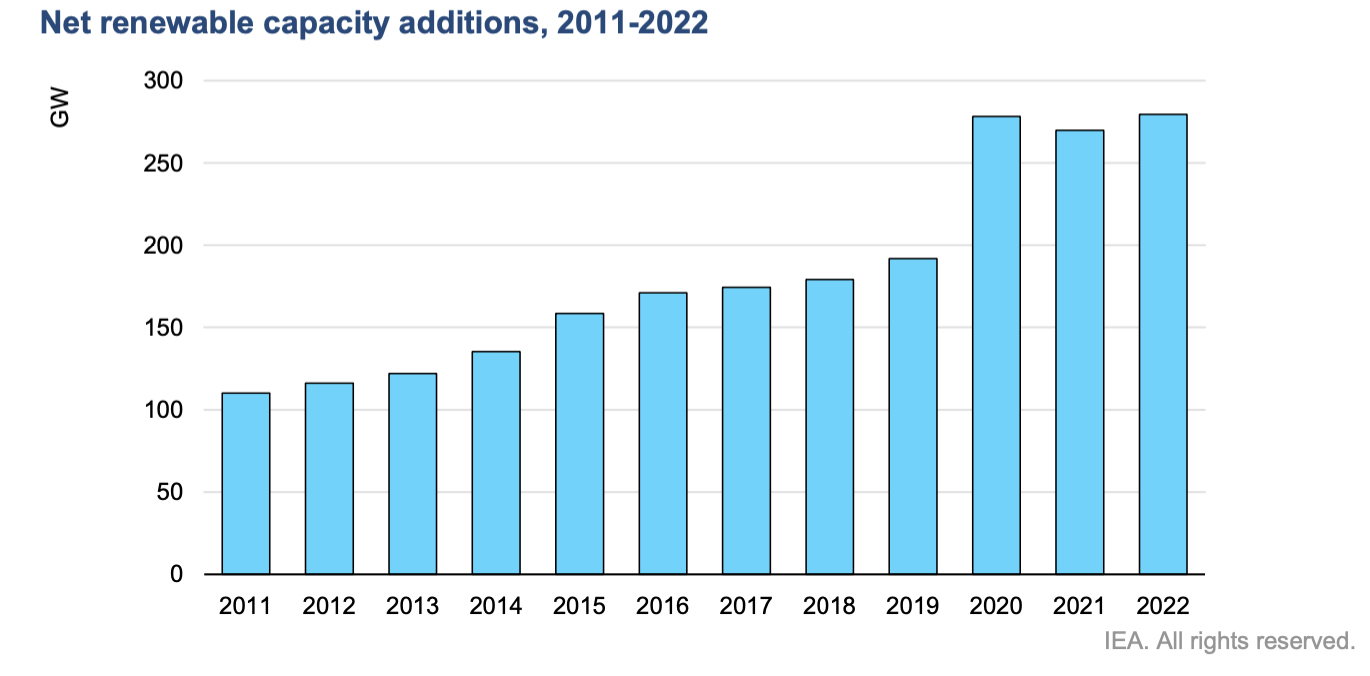
Figure 3 shows net renewable capacity additions (IEA, 2021a)
The two leading countries that contributed the most to the renewable energy sector in 2020 were China and the United States. According to the International Energy Agency (IEA), renewable energy sources are expected to account for 90% of the total increase in global power capacity in 2021 and 2022. The total renewable energy addition capacity in Europe alone is estimated to increase by 11% to 44 GW and 49 GW in 2021 and 2022, respectively. Likewise, the renewable energy capacity is forecasted to increase by 25% in the United States by the end of 2021 (IEA, 2021a).
Solar Energy Statistics
With more than 486GW of installed capacity, solar energy is one of the world's most significant renewable energy sources. Ritchie and Roser (2020) suggest that Solar’s per capita energy consumption was 1,764 kWh in Australia, 815 kWh in the US, and 797 kWh in Spain in 2019, as shown in figure 4. Photovoltaic (PV) solar technology is dominant in many parts of the world. The world leaders in solar PV technology are China, the United States, Germany, Italy and India. The usage of concentrating solar power (CSP) technology is also in the rise in recent years. Spain is the leading country in CSP technology and has 42% of the global CSP capacity.
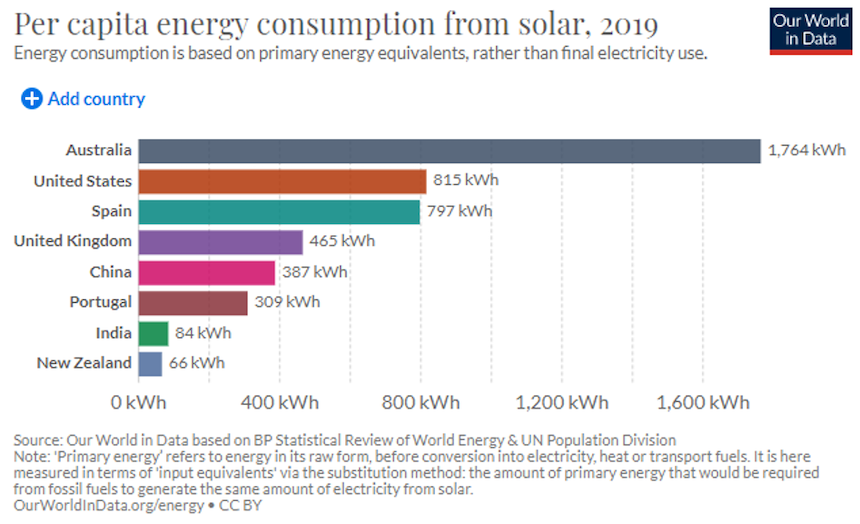
Figure 4 shows per capita solar energy consumption (Ritchie and Roser, 2020)
The solar capacity in Asia expanded to 78GW in 2020, which significantly contributed to the global solar energy capacity. China and Vietnam accounted for 49 GW and 11 GW of capacity increase, respectively. Likewise, Japan contributed to more than 5 GW additions in solar energy while India and the Republic of Korea expanded their solar capacity by more than 4 GW. In the United States, more than 15 GW of solar energy capacity was added in 2020 (IEA, 2021a). With this addition, solar capacity has now almost reached the same level as the global wind capacity. The global electricity generation from solar energy in 2020 was over 800 terawatt-hours (TWh), as shown in figure 5 (Ritchie and Roser, 2020).
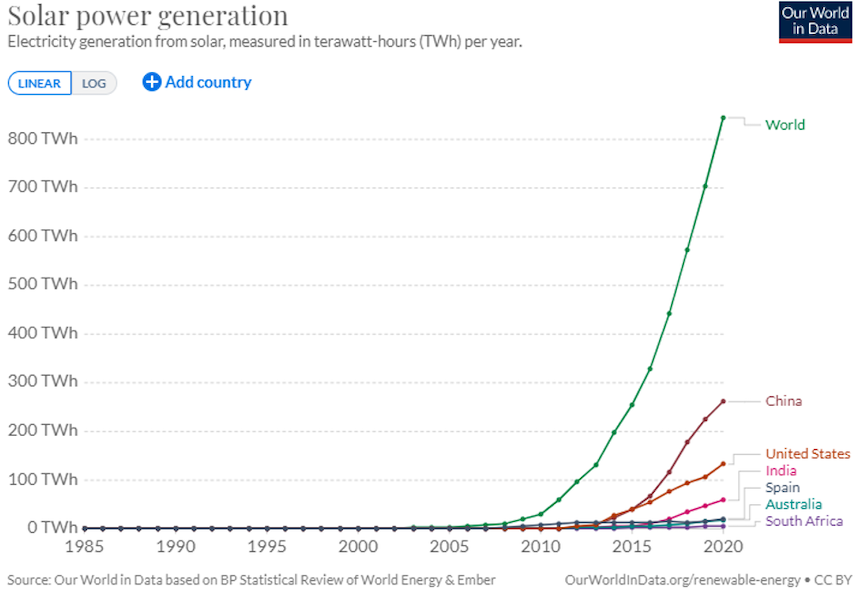
Figure 5: Solar Power generation (Ritchie and Roser, 2020)
According to U. S. Energy Information Administration (EIA), more than 15.4 GW of solar energy capacity will be added to the electric power sector in the US alone by the end of 2021. The EIA has further forecasted that solar energy will account for over 39% of the electricity generation capacity in the United States in 2021 and may even exceed wind energy capacity for the first time.
Also Read: Top 15 Renewable Energy Jobs of 2022 for Jobseekers
Wind Energy Statistics
Wind energy is one of the most extensively used renewable energy sources with a global installed wind power capacity greater than 563 GW and accounting for around 24% of the total renewable energy generation capacity since 2018. Ritchie and Roser, (2020) report suggest that the per capita energy consumption from wind was 6,928kWh in Denmark, 3,735 kWh in Germany and 2,352 kWh in the UK in 2019 (figure 6). Wind energy technology is a modern renewable energy technology advancing rapidly in many parts of the world each year.

Figure 6: Per capita wind energy consumption (Ritchie and Roser, 2020)
In 2020, the addition in the global wind capacity doubled its record of 2019 with an addition of 114 GW. China alone expanded its wind power generation capacity by 71.6 GW, accounting for two-thirds of the global wind capacity. With this addition, the total wind capacity of China has reached 281 GW (Xu and Stanway, 2021). Following China is the United States, with an additional 14 GW in 2020 and earning a total installed wind capacity of 118 GW (EIA, 2021). According to Ritchie and Roser (2020), the annual electricity generation from wind energy was highest in the United Kingdom, with 73.78 terawatt-hours per year in 2020 (Figure 7).

Figure 7: Wind power generation (Ritchie and Roser, 2020)
Many other countries such as India, Germany, Australia, Denmark and New Zealand are making significant advancements in wind powering technology. The Jiuquan Wind Power Base, with a capacity of 8 GW and located in China, is the biggest onshore wind farm globally. At the same time, the Walney Extension Offshore Wind Farm, with a capacity of 659 MW, is the biggest offshore wind farm located in the UK. According to IEA, the global wind energy capacity is forecasted to increase by 12% from 2021 to 2022 (IEA, 2021b).
Geothermal Energy Statistics
The installed capacity of geothermal energy has significantly increased over the last decade across the world. With the addition of 14 GW in 2020, geothermal energy has become the fifth-biggest renewable energy source for clean electricity generation. As of now, more than one-third of geothermal energy is used for electricity generation, and the remaining two-thirds is used for thermal applications. The United States, Indonesia, Kenya, Philippines, New Zealand and Italy are the world leaders in geothermal energy production, as shown in figure 8 below. Many geothermal power plants are still under development in the United States, Indonesia and Philippines. In 2020, the United States produced 18,366 gigawatts hours (GWh) of geothermal energy, the highest worldwide geothermal energy generated in a single year (Statista, 2021). Experts worldwide have estimated that global geothermal power generation capacity can reach over 28000 MW in the coming 15 to 20 years.
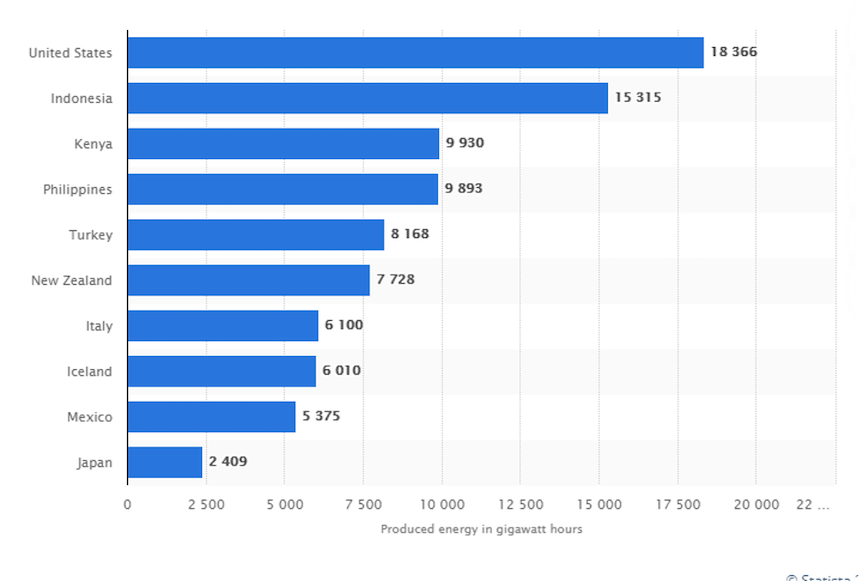
Figure 8: Geothermal Energy Generation Worldwide in 2020, (Statista 2021)
Hydro Energy Statistics
Hydro energy or hydroelectric power has been the oldest source of renewable energy harnessed from prehistoric times. Hydro energy still accounts for over 60% of the total renewable energy generated globally, excluding biomass. Figure 9 shows a widely used carbon-free energy source in urban and rural areas with a global installed capacity greater than 1330 GW in 2020 (International Hydropower Association, 2021). This indicates that the average one-year growth of 1.6% is higher than the previous year's growth rate.

Figure 9: Hydropower installed capacity growth (International Hydropower Agency, 2021)
IEA has estimated that the hydropower energy sector will be the dominant source of clean electricity by 2050 (IEA, 2021b). According to International Hydropower Agency (2021), East Asia and Pacific installed the highest hydropower capacity, which is 14 466 MW, followed by Europe (3,032MW) in 2020, as shown in figure 10 below.
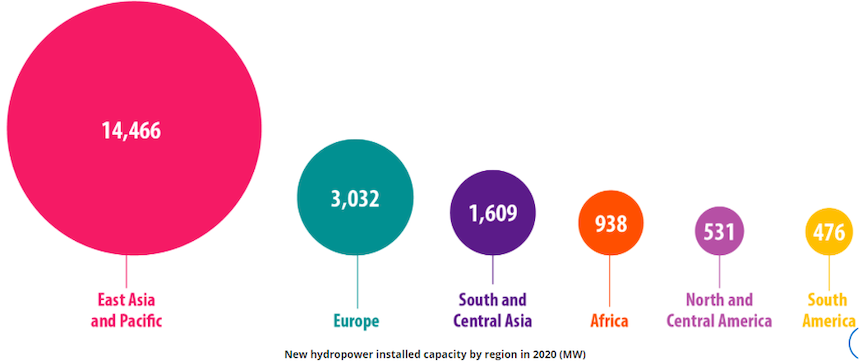
Figure 10: New hydropower installed capacity by region in 2020 (International Hydropower Agency, 2021)
Hydropower generated over 4370 terawatt-hours (TWh) of usable electricity in 2020, nearly equal to the total annual electricity consumption in the United States. Many hydropower projects producing 21 GW of electricity were put into operation in 2020 despite the global crisis due to the COVID-19 pandemic. China alone accounted for two-thirds of the worldwide addition of hydropower capacity with 13.8 GW of new capacity. With this significant addition, China tops the list in the hydro energy sector with a total installed capacity of 370 GW. Brazil, the United States, and Canada are following China, with a total installed capacity of 109 GW, 102 GW, 82 GW and 50 GW, respectively, in 2020 (International Hydropower Agency, 2021).
Biomass Energy Statistics
Biomass energy is one of the largest renewable sources, which accounts for more than 14% of the energy consumption in the world (World Bioenergy Association, 2020). Figure 11 shows that China's highest biomass energy capacity soared up to 18,687 MW, followed by Brazil to 15,650 MW in 2020 (Statista 2021). The leading countries in biomass energy capacity are Brazil, China, the United States, India and Germany. Similarly, bioenergy has become the primary renewable energy source in Denmark. According to Energy Statistics (2018), Denmark used 64% of renewable energy generated from bioenergy, 48% from wood biomass alone in 2018.
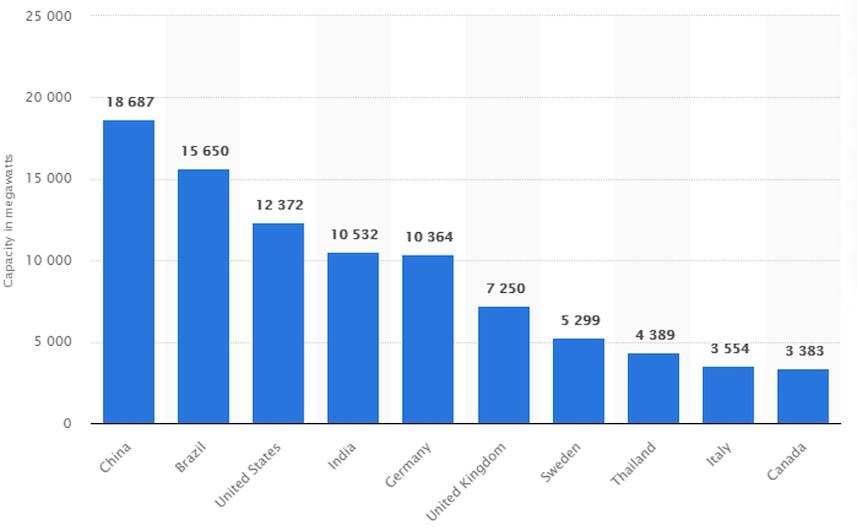
Figure 11: Global Bioenergy Capacity in 2020 (Statista, 2021)
Also Read: Top Renewable Energy Career Paths to Take in 2022
Conclusion
The global power production utilizing renewable energy sources has increased considerably even amidst the COVID-19 pandemic in 2020. If such growth continues even this year (2021), renewables will account for over 90% expansion in the global power capacity by the end of 2022. The significant development and breakthrough in green energy technologies, changes in energy policies, and increasing awareness of sustainable energy use have considerably increased clean energy production globally. With an increased inclination towards the renewable energy sector, the world is finally entering a new clean and sustainable energy era.

 How it Works
How it Works Pricing
Pricing FAQ
FAQ Quiz
Quiz Contact Us
Contact Us
